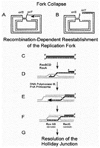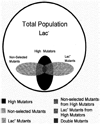Mechanisms of stationary phase mutation: a decade of adaptive mutation
- PMID: 10690404
- PMCID: PMC2922758
- DOI: 10.1146/annurev.genet.33.1.57
Mechanisms of stationary phase mutation: a decade of adaptive mutation
Abstract
A decade of research on adaptive mutation has revealed a plethora of mutagenic mechanisms that may be important in evolution. The DNA synthesis associated with recombination could be an important source of spontaneous mutation in cells that are not proliferating. The movement of insertion elements can be responsive to environmental conditions. Insertion elements not only activate and inactivate genes, they also provide sequence homology that allows large-scale genomic rearrangements. Some conjugative plasmids can recombine with their host's chromosome, and may acquire chromosomal genes that could then spread through the population and even to other species. Finally, a subpopulation of transient hypermutators could be a source of multiple variant alleles, providing a mechanism for rapid evolution under adverse conditions.
Figures


Similar articles
-
Adaptive mutation: implications for evolution.Bioessays. 2000 Dec;22(12):1067-74. doi: 10.1002/1521-1878(200012)22:12<1067::AID-BIES4>3.0.CO;2-Q. Bioessays. 2000. PMID: 11084622 Free PMC article. Review.
-
Mechanisms of mutation in nondividing cells. Insights from the study of adaptive mutation in Escherichia coli.Ann N Y Acad Sci. 1999 May 18;870:133-45. doi: 10.1111/j.1749-6632.1999.tb08873.x. Ann N Y Acad Sci. 1999. PMID: 10415479 Free PMC article. Review.
-
Selection and Plasmid Transfer Underlie Adaptive Mutation in Escherichia coli.Genetics. 2018 Nov;210(3):821-841. doi: 10.1534/genetics.118.301347. Epub 2018 Sep 7. Genetics. 2018. PMID: 30194073 Free PMC article.
-
Evolution in Long-Term Stationary-Phase Batch Culture: Emergence of Divergent Escherichia coli Lineages over 1,200 Days.mBio. 2021 Jan 26;12(1):e03337-20. doi: 10.1128/mBio.03337-20. mBio. 2021. PMID: 33500336 Free PMC article.
-
Evidence that stationary-phase hypermutation in the Escherichia coli chromosome is promoted by recombination.Genetics. 2000 Apr;154(4):1427-37. doi: 10.1093/genetics/154.4.1427. Genetics. 2000. PMID: 10747042 Free PMC article.
Cited by
-
Reduction of GC --> TA transversion mutation by overexpression of MutS in Escherichia coli K-12.J Bacteriol. 2000 Sep;182(17):5025-8. doi: 10.1128/JB.182.17.5025-5028.2000. J Bacteriol. 2000. PMID: 10940054 Free PMC article.
-
Polymerases leave fingerprints: analysis of the mutational spectrum in Escherichia coli rpoB to assess the role of polymerase IV in spontaneous mutation.J Bacteriol. 2004 May;186(9):2900-5. doi: 10.1128/JB.186.9.2900-2905.2004. J Bacteriol. 2004. PMID: 15090533 Free PMC article.
-
Hypermutation in bacteria and other cellular systems.Philos Trans R Soc Lond B Biol Sci. 2001 Jan 29;356(1405):29-39. doi: 10.1098/rstb.2000.0745. Philos Trans R Soc Lond B Biol Sci. 2001. PMID: 11205327 Free PMC article. Review.
-
The evolution of plastic recombination.Genetics. 2005 Oct;171(2):803-12. doi: 10.1534/genetics.105.041301. Epub 2005 Jul 14. Genetics. 2005. PMID: 16020791 Free PMC article.
-
Quiescence unveils a novel mutational force in fission yeast.Elife. 2017 Dec 18;6:e27469. doi: 10.7554/eLife.27469. Elife. 2017. PMID: 29252184 Free PMC article.
References
-
- Ames BN, McCann J, Yamasaki E. Methods for detecting carcinogens and mutagens with the Salmonella/mammalian-microsome mutagenicity test. Mutat. Res. 1975;31:347–364. - PubMed
-
- Andersson DI, Slechta ES, Roth JR. Evidence that gene amplification underlies adaptive mutability of the bacterial lac operon. Science. 1998;282:1133–1135. - PubMed
-
- Arjan J, de Visser GM, Zeyl CW, Gerrish PJ, Blanchard JL, Lenski RE. Diminishing returns from mutation supply rate in asexual populations. Science. 1999;283:404–406. - PubMed
Publication types
MeSH terms
Grants and funding
LinkOut - more resources
Full Text Sources
Other Literature Sources
Molecular Biology Databases

